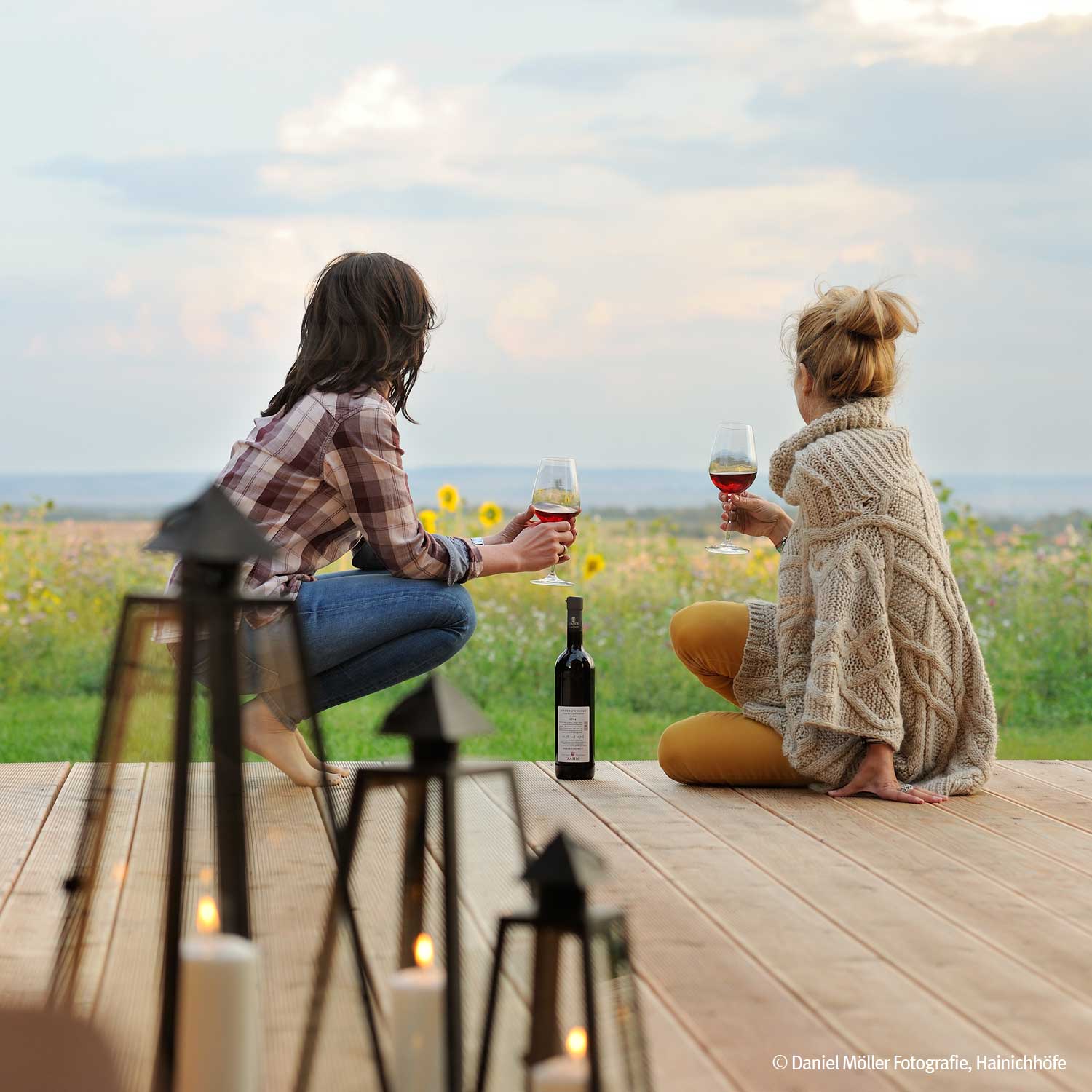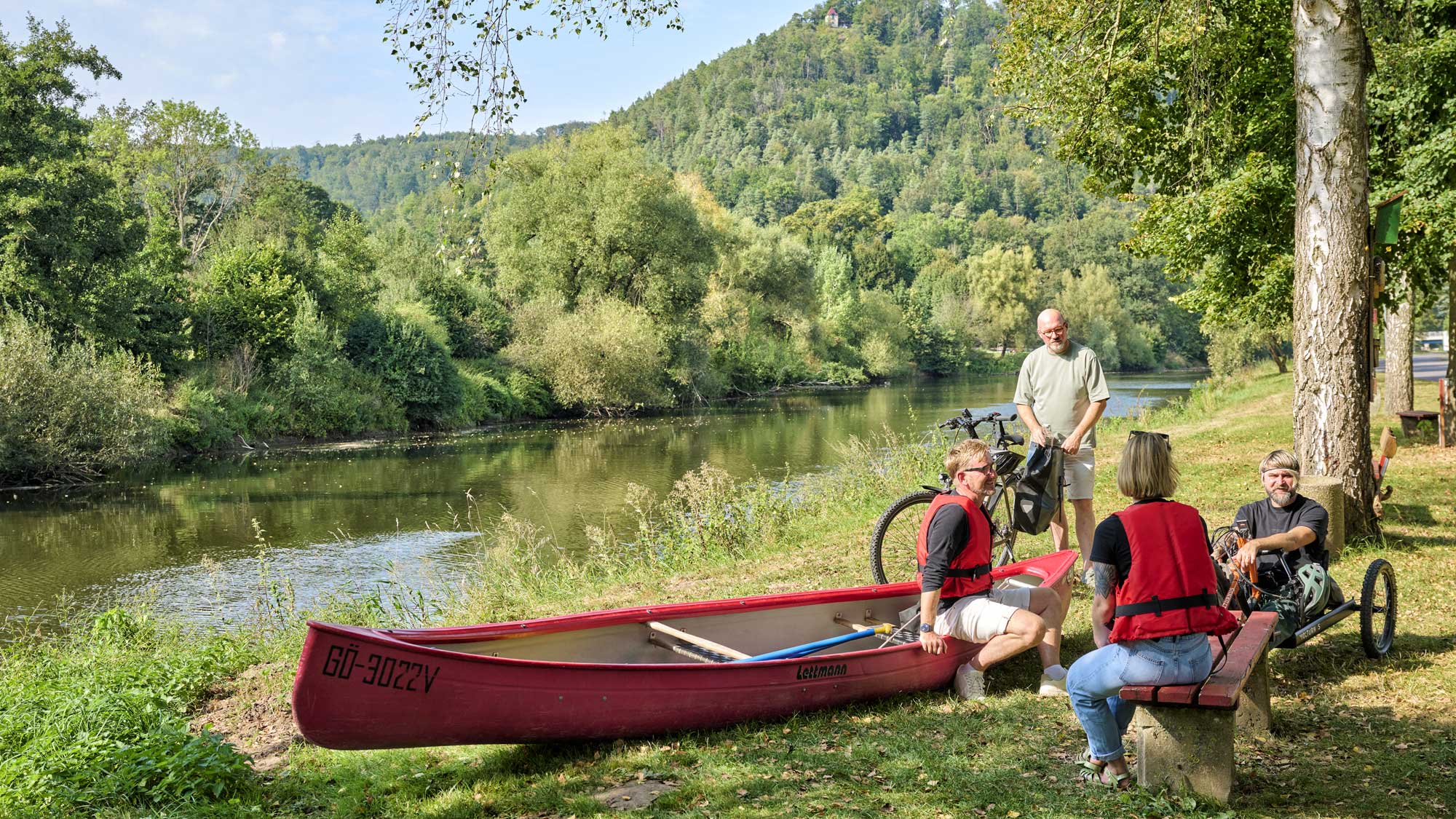You're in the right place! Whether in nature, in the middle of the city, for families, in the countryside, historic or traditional: among Thuringia's TOP hosts, everyone will find exactly the right address.
Along the Werra Valley Cycle Route
Wartburg Castle, Creuzburg, Normannstein Castle
This is how we like cycling: no cars far and wide, the crickets are chirping and the cycle path leads through the forest, sometimes between flowering meadows and rolling fields, sometimes through little towns and villages. The Werra, the river that forms the central theme for our tour, remains almost constantly in view. On this sunny Sunday in summer, we are making good progress, the track is almost even and is excellently signposted. Time and again, we find ourselves accompanying the canoeists on the river, cycling alongside them, standing on the bank and watching them. For example at the canoe station here in Creuzburg. There, families are supplied with what they need, children are given fluorescent orange and red life jackets, paddles are distributed.
It is often not sporty canoeists who are out and about here on the Werra, but fun lovers and bon vivants. Some have stretched parasols over their boats, children dangle their feet in the water, the man over there is playing the guitar and his whole family is singing along. There is almost always a picnic basket on board. The boats move down the river at a leisurely pace. A summer scene full of joie de vivre.
Everything is falling into place for us too; the breaks are the best thing about the cycle route. For example in Creuzburg: the castle is visible from the distance. Built in around 1170, it is one of the larger Romanesque castle complexes in Germany and is the focus point of the little town. It was the residence of the Thuringian landgraves and a visiting place of St Elisabeth. Nowadays it is a popular destination for excursions with a restaurant, viewing terrace, castle museum, a historic torture chamber, a pottery workshop and a little park. Every year at Pentecost, the medieval market takes place in the castle courtyard – with a lot of tomfoolery, dance and the whole medieval kerfuffle: palm-reading, raffishly dressed craftsmen, and bakers baking dangerous-looking things.
The Werra Valley Cycle Route is one of the most beautiful cycle routes in Germany. The Werra winds from the heights in the Thuringian Forest Nature Park to Hannoversch Münden in Lower Saxony, where the Werra and the Fulda converge to form the Weser. The cycle route starts in Neuhaus am Rennweg, really close to where the river emerges from two sources. The course of the route often adapts to the turns in the river. It covers approximately 309 kilometres, around 200 of which lead through Thuringia. The beautiful theatre town of Meiningen and Bad Salzungen with its brine bath and the impressive graduation house are located on the route. Eisenach is also not far away. However, the true discoveries are the quiet corners and the little towns by the river, for example Treffurt, Creuzburg, Lauchröden or Themar.
This is the second day of our weekend tour, which will lead from Gerstungen to Treffurt. We have deliberately kept the stages short, just 30 to 40 kilometres a day. It would be a waste to do more, as there is so much to discover here. Even though the start of the route was unspectacular: in Gerstungen, a small municipality with not much more than an attractive centre, a pub or two and the Werra Stadium right by the river, whether the local youth plays football against the competition from the region. Rural Saturday morning pleasures – between the cycle route and the Werra. Leisurely cycling without major ups and downs, through luminous green beech forests, through fields and meadows. In Hörschel, where the Rennsteig ridge walk begins, we turned to the right away from the Werra Valley Cycle Route and rode the 11 kilometres of the Herkules-Wartburg Cycle Route to Eisenach, the destination of this first stage – a cultural highlight of the tour and a good place to spend the night. We were there early enough to take a stroll through Wartburg Castle in the late afternoon. There is a wide selection of hotels in Eisenach – and of restaurants. On the first evening, we were in agreement. We wanted to go for Thuringian classics: roulade with dumplings, accompanied by a glass of cool Thuringian white wine from the Saale-Unstrut region – what more could a cyclist’s heart desire?
East Germany and the former border between East and West are a recurring theme on this cycle tour. For example, when we suddenly come across one of those brown signs with the inscription: “Here, Germany and Europe were divided until 9 a.m. on 24 March 1990”. Or when we are looking for the right path on the cycling map and see the course of the Hessian-Thuringian border. Or when we encounter, by the side of the path, one those guardhouses which once housed the checkpoints for the five-kilometre restricted zone, making life difficult for people in the border region. Places that have written history pop up, for example Grossburschla: the village was separated from its own train station as a result of the border and was in “the zone” after 1945. But the Iron Curtain fell in 1952. Grossburschla was enclosed like a prison. Surrounded on three sides by the border with barbed wire, spring guns and minefields, the village protruded into Hesse. It was only on 13 November 1989 that the day of reunification came for this region – when the barrier between Grossburschla and the station of Grossburschla opened. Today, you can walk parts of the former patrol road on various hiking routes along the German Green Belt.
Treffurt is the destination of our tour. The attractive half-timbered town is located in the Eichsfeld-Hainich-Werra Valley Nature Park and on the outskirts of Hainich National Park. The 12th century Normannstein Castle rises above the town with its three towers. It was built to protect the three fords through the Werra that gave the town its name. The town is surrounded by extensive deciduous forests and by the Heldrastein, the highest mountain in the Werra Valley at 503 metres. From there, you can enjoy a magnificent view far over the Werra Valley. We want to go up there in the late afternoon. Now, however, we need to get cycling again: it is still twelve kilometres to Treffurt. From Creuzburg, via Mihla and Frankenroda, where we – shortly before reaching our destination – take another break. Simply sitting and watching the canoeists. That is the life. At the corner, there is a sign to “Café Gisela”. There is sure to be a coffee and strawberry cake there – wouldn’t that be great?

The Werra Valley Cycle Route is one of the most popular cycle routes in Germany. The around 300-kilometre route takes you from the sources of the Werra at the Rennsteig through interesting places and attractive landscapes, past imposing castles and palaces.
Header picture: Creuzburg Castle, ©Christoph Partsch, Welterberegion Wartburg Hainich e.V.
Picture Infobox: Paddling near Frankenroda, ©Joachim Negwer, Thüringer Tourismus GmbH
Accessibility
Did you like this story?
You might also be interested in ...



















